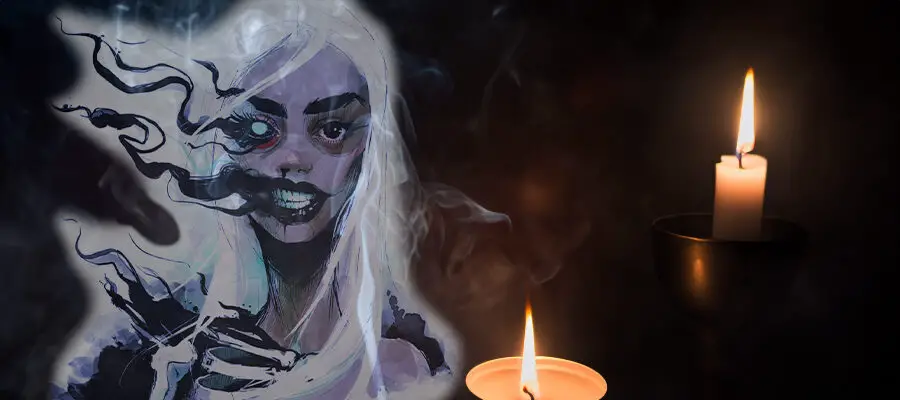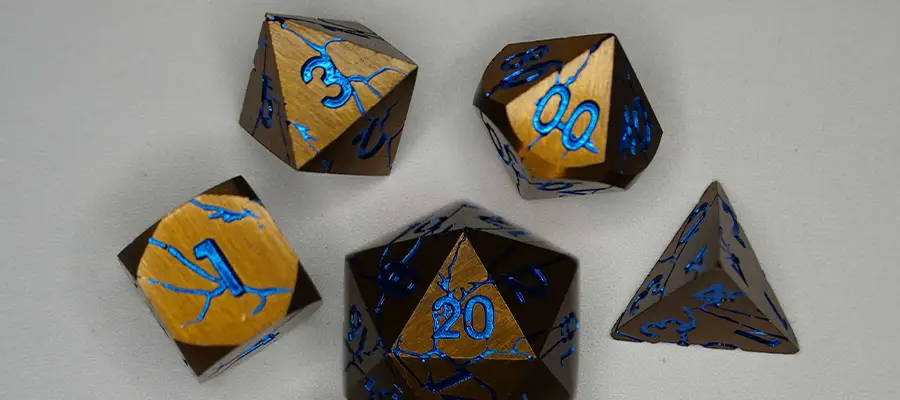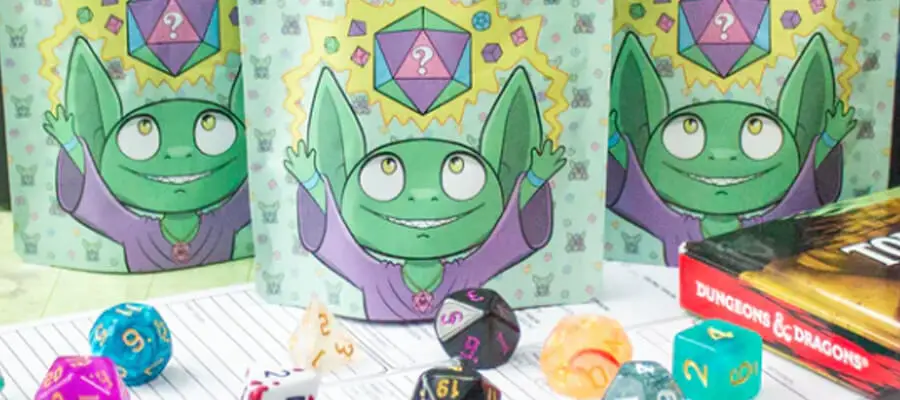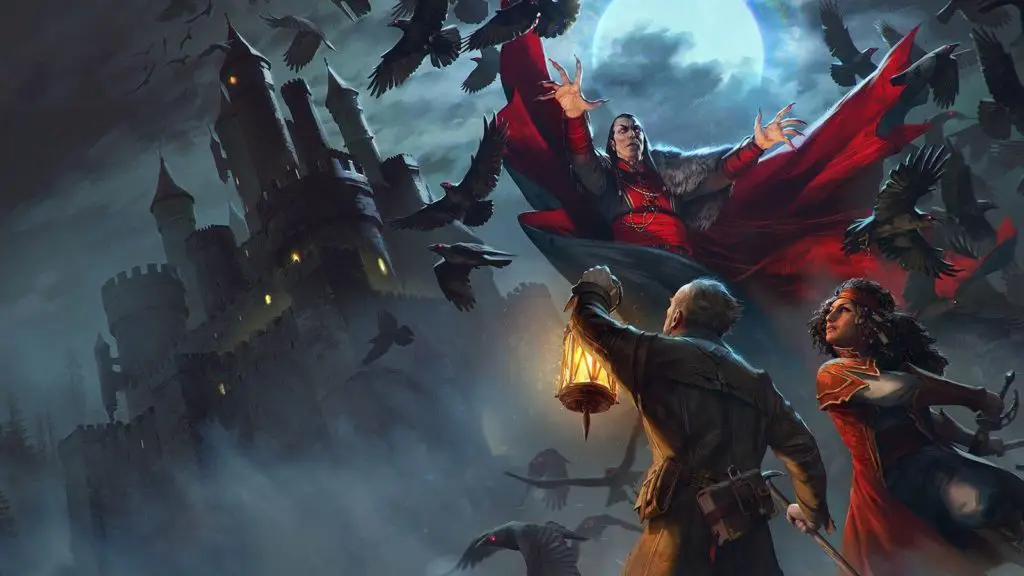Candela Obscura review article featured image is a blend of art from Candela Obscura and a generated background by Adobe. This article contains affiliate links to put gold in our coffers.
In 2023, Critical Role announced, developed, and published Candela Obscura, their first of a trilogy of tabletop games announced in the wake of the OGL crisis. While Wizards of the Coast was out here making enemies out of… well… everyone, Critical Role built a team of rockstar designers in tabletop for their games division, Darrington Press, and announced active development on their new system, Illuminated Worlds. When I heard they hired industry darling Spenser Starke to design a new TTRPG for them, you could say my interest was piqued. Over time, it was revealed this game would be our first look at the Illuminated Worlds system. It was apparently a Victorian mystery game, and they had an actual play planned to showcase it.
When the Quick Start dropped in May, we learned that this was to be a cosmic horror mystery game that would tread the same waters of games like Call of Cthulhu, Monster of the Week, and Vaesen, wherein you take on the role of an Investigator who has been brought in as a member of a secret, likely occult society. It was rocky roads from the get-go for Candela Obscura when comparisons were made between it and John Harper’s Blades in the Dark, and it hasn’t been able to successfully remove that stigma. While an acknowledgment of the inspiration appears, and John Harper has publicly endorsed the adaptation, it didn’t halt the onslaught of questions, criticism, and accusations of laziness that continue to this day.
Quick Foreword
I want to say something before I continue this review. After I read the book and formed an opinion, I asked other content creators what their experiences were like when they said anything but glowing praise for a Critical Role product. Three of them told me to be prepared for death threats, and another told me to avoid it like the plague unless I wanted to damage my reputation in the TTRPG industry. All of this, despite knowing that there are people who will buy this thing, open it once, and then let it collect dust on their shelf.
I’m doing this review because there are non-subjective problems with this game, and I don’t think compliance under the threat of violence or industry blacklisting is acceptable. I am not saying Critical Role is responsible for these reactions, and this review isn’t some kind of “punishment” for their fans’ behavior. There are plenty of people in the credits of this book who I highly respect, and have even discussed working with, but this is a game with legitimate problems. Problems are worth discussing so that we can learn from the mistakes and keep consumers informed on their purchasing decisions. I hope our hobby hasn’t degraded so far as to be unwilling to allow scrutiny.
Summary
We’re going to get into my dissection of the game, but as a quick summary, Candela Obscura doesn’t have the ludonarrative innovation to justify itself in an already saturated genre. It spends way too much of its page count trying to say the right thing rather than doing the right thing, making the entire affair feel like a pretentious lecture of potential prejudiced themes in gaming.
What’s here is an intriguing setting with smart artwork choices, such as the use of field-observation style sketches for more gory pieces to keep things less “bloody and edgy”, but it fails to earn its place at the table. Horror tabletop roleplay is dominated by the likes of Call of Cthulhu, Mothership, and Vaesen, and Candela Obscura is fraught with errors and just doesn’t bring anything new to make me want to clear some shelf space. This would have been infinitely better served as a campaign setting rather than a boutique, Victorian Blades in the Dark ruleset serving as a hollow pastiche of Vaesen.
The Candela Obscura Review
In summary, this is a d6-based dice pool system with a success gradient. You generally succeed in an action you take by rolling a 4 or higher, and you take the highest result of any of the d6s rolled in the pool to determine the result. You determine the amount of dice in the pool by seeing how many points you have in the related action. Let’s say, for example, I have 2 points in Survey. That means I roll two d6s and use the highest result.
It distinguishes itself from Blades in the Dark with the Gilded Die, a special d6 you can roll during an Action in place of one of the other d6s if that Action is Gilded for you (indicated by the diamond to the left of the Action). Unique to this die is that you can take its result instead of the others, even if it is lower, to replenish another resource called Drive.
Drive can be spent to add dice to the pool of an Action roll that corresponds to that Drive. For example, my 2 points in Survey gives me 2d6 to roll on that Action. If I spend 1 Drive from Intuition, I gain an additional d6 to the roll for 3d6 in total. Your character’s Drive is replenished from the Gilded die mechanic and through recovering and training between assignments.
There’s also the Resistance mechanic, essentially a “get out of jail free” card for when the GM decides the plot needs you to take damage. I say that because the combat is basically the “don’t track hit points” mentality but codified. This was the moment Candela Obscura absolutely lost me. I don’t feel any legitimacy or tension behind enemies that choose violence here. Other systems this game takes shots at have more interesting ideas for handling this that don’t require as much of this railroad “Combat goes on until the GM says so” mentality in more intriguing ways. It makes this known to the Player Characters in the rulebook, so it already shows the magician’s secrets to the player characters. Vaesen has an incredibly interesting aspect of combat that rewards discovering weaknesses and rituals that make this entire chapter on combat feel like homework turned in 5 years too late. I guess the absolutely abysmal combat makes sense, considering they apparently omitted PC death mechanics… or at least entirely forgot them in the first print.
Missing Death
Yeah, that’s right. In the first print, the game is missing a failure state. This was also true of the initial Quick Start and has been patched in through an errata, but I can’t help but speculate this was an intentional decision until they got pressed on it. What they inserted was essentially one-for-one the mechanics from Blades in the Dark, but it’s pretty clear they aren’t comfortable committing to the idea that the game should tell you you die. What they have in the Errata is fine, and I don’t think you have to have Death to make a game risky, but this feels like a pretty significant omission.
Honestly, I think they may have missed an opportunity here to not only distinguish Candela Obscura from its predecessors but also explore a unique horror we don’t often see: the horror of immortality. The errata means this absolutely wasn’t the thing they wanted to do with it, but the spark is definitely there.
User Experience
The layout is pretty, but I feel the organization of information isn’t always intuitive for character creation. They grouped all Roles and Specialities together with the type of information you need, rather than sorting the information you need on a page with the other information of your Role and Speciality. As someone who makes a large chunk of my income off layout design, I’m not sure why it was decided to parse this out over the span of 30 pages rather than make all the information clear in the same section, like what Blades in the Dark did. I’ll show you what I mean:
In order for me to make a character that is a Soldier, the information I need on my sheet could easily fit on one page. However, all the information I need is instead on:
p. 21: Role & Specialty Descriptions (This is all flavor text)
p. 25: Specialty Action Ratings
p. 26: Specialty Drives & Gild Actions
p. 27: Muscle Abilities
p. 29: Soldier Abilities
p. 54: Soldier Illumination Keys
This just seems unintuitive by design, especially when Blades in the Dark already did the more natural layout of the information. This isn’t Critical Role’s first rodeo in print production, so this had to be an intentional choice. If you feel this is a nit-pick, that’s fine, it’s just something I feel hurts the overall accessibility of character creation.
Vaesen Did Candela Obscura Better
After I read the book, I did a side-by-side comparison of Candela Obscura and Blades in the Dark. If you want a clear-cut answer to the question, “Is Candela Obscura just Blades in the Dark?” The answer is “kind of.” It’s the same resolution mechanics, palette swaps of other mechanics, a non-Duskvol setting and aesthetic for the game, as well as a change in concept for investigative horror mysteries.
There are numerous similarities, but it’s disingenuous to frame it as if Critical Role was trying to get away with plagiarism. They went about ethically doing this and brought on the Blades in the Dark crew for contributions. Despite this, Candela Obscura has managed to be less than its predecessor and feels even more “less than” when considering that it wasn’t trying to be Blades in the Dark. It doesn’t even want to be Call of Cthulhu, either. What it wants to be is Vaesen, a game that just crossed over its 3-year birthday and continues to take home ENnies year after year.
That’s where I get hung up reading through Candela Obscura. Every time I make it through a mechanic, I’m reminded how much better I feel Vaesen achieves the concepts.
Pretension
In fact, an argument could be made that Candela Obscura would rather take things away from pre-established titles that are currently still seeing mainstream play in a near narcissistic way. The thing you don’t do as a game creator is tell your audience how not to run their games. You can’t prevent someone from roleplaying a horrible person. You can hold yourself to an ethical standard of not gamifying things that your predecessors did that we have criticized and now found unconscionable, but it’s ridiculous to think you’re preventing racism by preemptively lecturing readers of your text.
That’s not even the most bizarre thing; Candela Obscura attempts to knock its sources of inspiration down a peg. Seriously, it’s the first game I’ve seen where the designers went out of their way to dig at other games they credit as inspiration. The first paragraph of p. 9 on the Quick Start doesn’t appear in the printed book, likely for good reason. It states:
“In our experience, roleplaying “insanity” is neither ethical nor mechanically viable.”
This sentence wouldn’t be so insufferable if they hadn’t gamified disabilities on the same page.
I’m going to riff off a point brought up by Justin Alexander in his fantastic review of the Candela Obscura Quick Start. As a physically disfigured and disabled person, I have to ask: Why did you all feel it was ableist to mechanically express and otherwise gamify mental disabilities, but it was fine to do so with physical disabilities? At this point, the Quick Start is dated to May 30th, making it just over 5 months old, and this whole portion of your ruleset hasn’t been addressed.
Hyper-Sanitized
I actually really disagree with the premise that the themes of madness can’t somehow be expressed in a game. Vaesen does so without muss or fuss,
It’s almost like it’s trying to convince you not to play it, and the over-sanitized, hyper-editorialized passages constantly reminding you that themes of the genre are “problematic” just come off as preachy, moralistic grandstanding.
This is the difficulty with critiquing outspokenly-progressive media as a progressive. It would be so much easier to say what I want to say if I were some right-wing Grognard nut job, but no, I just had to be born with empathy and a weakness for socialism and femboys.
I’m not disappointed because “there’s no bigotry” in the game; I’m disappointed because I spent $40 on a book with missing rules that would rather preemptively lecture me as if I was super down with bigotry. This sucks, because there’s a legitimate conversation to be had about these topics in the game industry, and I don’t think it was handled tastefully or tactfully here at all.
In Closing: Candela Obscura Review
Unfortunately, Critical Role’s first outing in the TTRPG creation space is a puddle claiming to be an ocean. It spends too much of its page count telling you how not to play it, and not enough telling you how to play it. I actually mean that literally here; there’s at least a page worth of core rules just missing from the first printing.
My guess is that Critical Role wanted an in-house System they knew they would have complete creative control over. I think this is absolutely fine, but I believe most people were expecting a bit more out of the Illuminated Worlds system than minor tweaks on Forged in the Dark. The market is full of Powered by the Apocalypse derivatives, so something that breaks away from a reskin and innovates on the dice roleplaying game formula is more likely to get sustained play.
Missed Opportunity
I can’t help but think about how cool this would have been as a Vaesen setting rather than its own proprietary thing. It’s not terrible as a Blades in the Dark supplement, but it seems to be shoehorning in way too much from Vaesen to get close to the feel but keep it in-house. I’m aware that’s a sort of assumption of the intentions of the creators, but Vaesen’s fingerprints are everywhere on this thing. I would have been unbelievably excited to have seen the Critical Role/Free League collaboration, but it seems everyone is chasing independent TTRPG success with a proprietary system, rather than attempting to collaborate.
This review isn’t making any accusations. Taking inspiration from a thing and reinterpreting it is absolutely a valid means of content creation, but I don’t need to harp on the lack of “twisting-the-yoink” to show the serious problems with this book.
Enjoyed the read? You can read more articles by Taron Pounds here or subscribe to his YouTube channel here.





I’ve played. My experience was analogous to a ride on the Haunted Mansion at Disney, nothing more than a spectator being pulled through a PG renaissance horror narrative. Without any real power to change the outcome of the situation, you are simply expected to play your part, and enjoy the story. I’m no expert, but it feels more tuned for those who enjoy RP more than the G. So if acting is your call, and you want to use dice to define some improv moments, give it a go.
That sounds like the worst to me 😛 I’d literally rather just do improv.